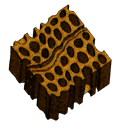Description
This thesis focuses on 3D ray tracing-based numerical simulations of the optical transmittance of TW.
In particular, we are interested in volumetric rendering of microstructure models, in order to determine the bulk visual properties of the material. Existing state-of-the-art (differentiable) rendering packages, such as Mitsuba 3, could be used, but may require adapting to this specific research project and available input data.
The results obtained from ray tracing simulations can then be compared to experimental results and to analytical predictions (available for simplified microstructures).
Unlike pristine wood, “Transparent Wood” (TW) is transparent to visible light. It is produced by infiltration of a transparent polymer in the cell structure of previously delignified wood, thus maintaining the cellulosic microstructure and excellent mechanical properties. TW is emerging as a promising alternative to petroleum-based materials with harmful plastics like polyvinyl chloride (PVC), polypropylene, and polyethylene. Therefore, TW is becoming a popular choice for energy-efficient buildings and sustainable construction projects.
The degree of transparency of TW depends on its complex microstructure and on the mismatch of the diffraction indices of the delignified cellulosic cell structure and the infiltrated polymer. This is why a microstructure-based approach is essential, as it allows the prediction of the optical performance of TW with respect to changes of wood source, polymer material and delignification/infiltration process. A representative volume element of the cellular microstructure of wood (see Figure below) is obtained from a recently developed computer code which accounts for the essential microstructural features of softwood and hardwood, including early wood/late wood rings, vessels, and ray cells.
A similar approach in 2D is presented in Pang et al. (2021), https://doi.org/10.1002/adpr.202100135.
Requirements
- Fluent in English (source code comments and written thesis should be in English)
- Knowledge of basic physically realistic rendering methods
- Programming skills in C++ and/or Python
Environment
The project will most likely rely on an existing ray tracing rendering software (to be selected during the literature review stage of the project), but could also be implemented in a stand-alone application if that turns out to be the more practical approach. In either case, we are looking for a student who is capable of understanding and adapting modern ray tracing code.
This project will be co-supervised by Markus Königsberger from the Research Unit of Structural Simulation and Timber Engineering
Additional Images and Files
| Attachment | Size |
|---|---|
| Fig. 1 | 46.96 KB |
